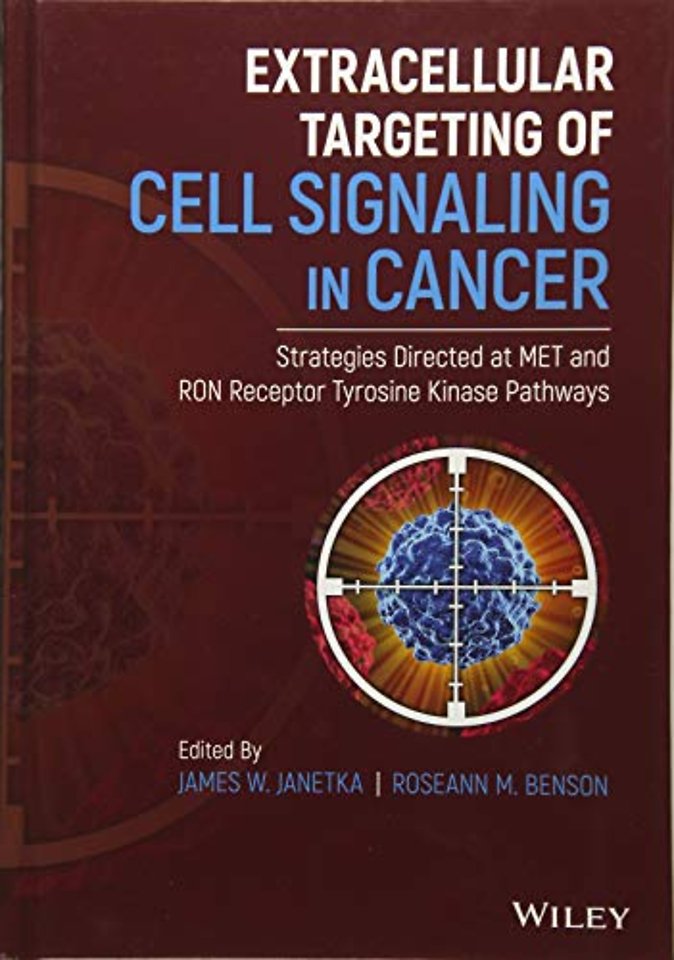Extracellular Targeting of Cell Signaling in Cance r – Strategies Directed at MET and RON Receptor Tyrosine Kinase Pathways
Strategies Directed at MET and RON Receptor Tyrosine Kinase Pathways
Samenvatting
International experts present innovative therapeutic strategies to treat cancer patients and prevent disease progression
Extracellular Targeting of Cell Signaling in Cancer highlights innovative therapeutic strategies to treat cancer metastasis and prevent tumor progression. Currently, there are no drugs available to treat or prevent metastatic cancer other than non–selective, toxic chemotherapy. With contributions from an international panel of experts in the field, the book integrates diverse aspects of biochemistry, molecular biology, protein engineering, proteomics, cell biology, pharmacology, biophysics, structural biology, medicinal chemistry and drug development.
A large class of proteins called kinases are enzymes required by cancer cells to grow, proliferate, and survive apoptosis (death) by the immune system. Two important kinases are MET and RON which are receptor tyrosine kinases (RTKs) that initiate cell signaling pathways outside the cell surface in response to extracellular ligands (growth factors.) Both kinases are oncogenes which are required by cancer cells to migrate away from the primary tumor, invade surrounding tissue and metastasize. MET and RON reside on both cancer cells and the support cells surrounding the tumor, called the microenvironment. MET and RON are activated by their particular ligands, the growth factors HGF and MSP, respectively. Blocking MET and RON kinase activation and downstream signaling is a promising therapeutic strategy for preventing tumor progression and metastasis. Written for cancer physicians and biologists as well as drug discovery and development teams in both industry and academia, this is the first book of its kind which explores novel approaches to inhibit MET and RON kinases other than traditional small molecule kinase inhibitors. These new strategies target key tumorigenic processes on the outside of the cell, such as growth factor activation by proteases. These unique strategies have promising potential as an improved alternative to kinase inhibitors, chemotherapy, or radiation treatment.
Specificaties
Inhoudsopgave
<p>Ch 2 – The role of HGF/MET and MSP/RON signaling in tumor progression and resistance to anticancer therapy<br />Lidija Klampfer; ProteXase Therapeutics, Inc., USA Benjamin Yaw Owusu; University of Alabama at Birmingham School of Medicine, USA</p>
<p>Ch 3 – HGF Activator (HGFA) and its inhibitors HAI–1 and HAI–2: Key players in tissue repair and cancer<br />Hiroaki Kataoka and Takeshi Shimomura; University of Miyazaki, Japan</p>
<p>Ch 4 – Physiological Functions and Role of Matriptase in Cancer<br />Fausto A. Varela, Thomas E. Hyland, and Karin List; Wayne State University, USA</p>
<p>Ch 5 – The cell–surface, transmembrane serine protease Hepsin: discovery, function and role in cancer<br />Denis Belit kin∗, Shishir Mani Pant∗, Topi Tervonen, and Juha Klefström; University of Helsinki, Finland</p>
<p>Ch 6 – Targeting HGF with antibodies as an anticancer therapeutic strategy<br />Dinuka M. De Silva, Arpita Roy, and Donald P. Bottaro; National Cancer Institute, USA</p>
<p>Ch 7 – MET and RON Receptor Tyrosine Kinases as Therapeutic Antibody Targets for Cancer<br />Mark Wortinger, Jonathan Tetreault, Nick Loizos, and Ling Liu; Eli Lilly, USA</p>
<p>Ch 8 – Inhibitory antibodies of the proteases HGFA, matriptase, and hepsin<br />Daniel Kirchhofer, Charles Eigenbrot, and Robert A. Lazarus; Genentech, USA</p>
<p>Ch 9 – Inhibitors of the growth–factor activating proteases matriptase, hepsin and HGFA: Strategies for rational drug design and optimization<br />James W. Janetka; Washington University, USA Robert A. Galemmo, Jr.; ProteXase Therapeutics, Inc., USA</p>
<p>Ch 10 – Cyclic peptide serine protease inhibitors based on the natural product SFTI–1<br />Jonathan M. Harris; Queensland University of Technology, Australia Blake T. Riley, Olga Ilyichova, David E. Hoke, and Ashley M. Buckle; Monash University, Australia</p>
<p>Ch 11 – Screening combinatorial peptide libraries in protease inhibitor drug discovery<br />Marcin Poreba and Paulina Kasperkiewicz; Sanford Burnham Prebys Medical Discovery Institute, USA Wioletta Rut and Marcin Drag; Wroclaw University of Technology, Poland</p>
<p>Ch 12 – Chemical probes targeting proteases for imaging and diagnostics in cancer<br />Pedro Gonçalves and Steven H. L. Verhelst; University of Leuven, Belgium</p>
<p>Ch 13 – Cancer Diagnostics of protease activity and metastasis<br />Timothy J. O Brien and John Beard; Stage I Diagnostics, Inc., USA</p>
<p>Ch 14 – Roles of pericellular proteases in tumor angiogenesis: therapeutic implications<br />Janice M. Kraniak, Raymond R. Mattingly, and Bonnie F. Sloane; Wayne State University School, USA</p>

